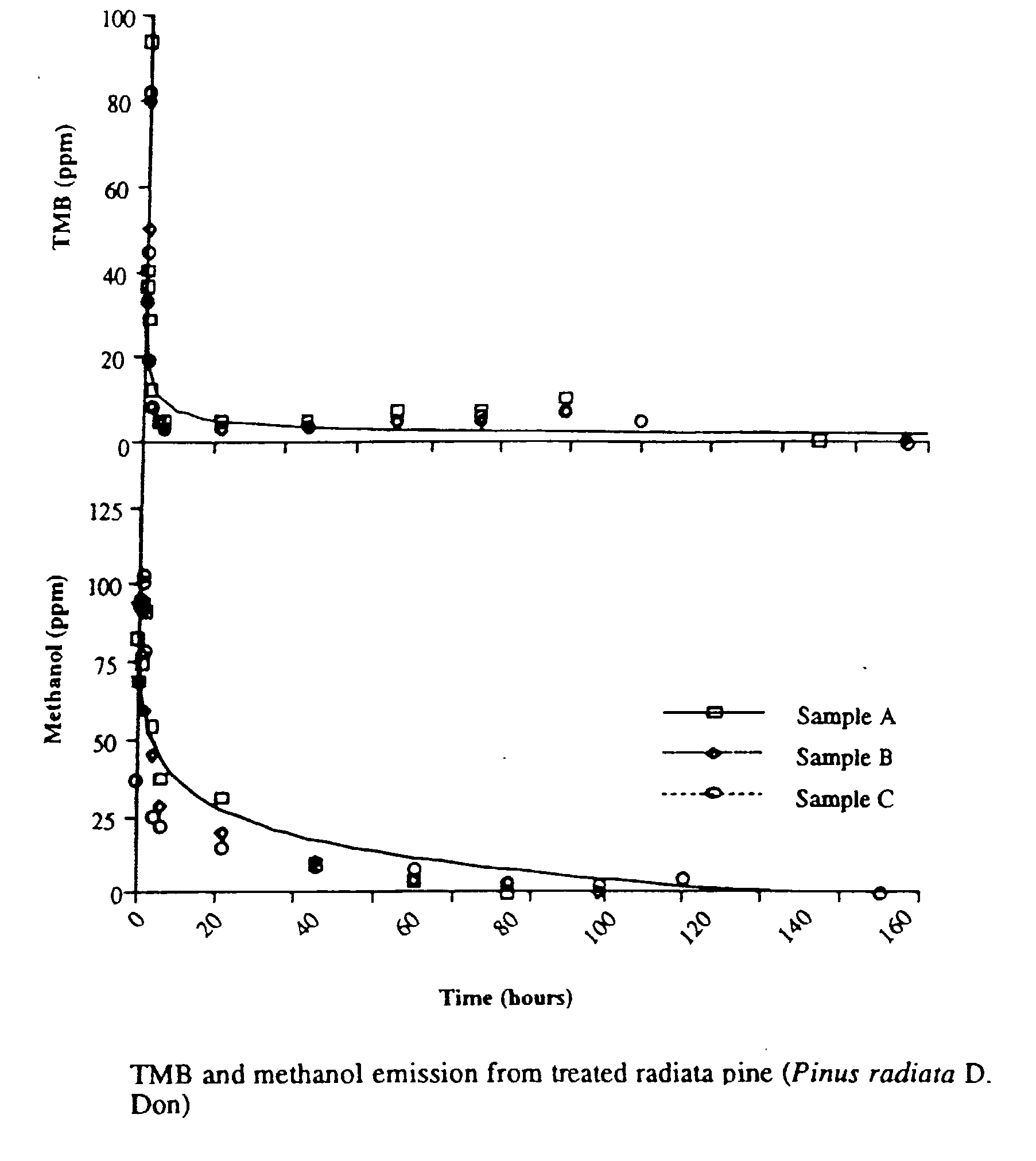Boron-based wood preservatives and treatment of wood with boron-based preservatives
a technology of boron-based preservatives and wood, which is applied in the direction of chemical vapor deposition coating, liquid/solution decomposition chemical coating, solid/suspension decomposition chemical coating, etc., to achieve the effect of facilitating treatment of wood without swelling, low alcohol content and safe handling
- Summary
- Abstract
- Description
- Claims
- Application Information
AI Technical Summary
Benefits of technology
Problems solved by technology
Method used
Image
Examples
example 1
[0100]Two samples of Eucalyptus Obliqua (Messmate) were kiln dried to 6% moisture content, end-sealed with epoxy resin and then impregnated with pure trimethyl borate by dipping at ambient temperature. The wood samples were subjected to an initial vacuum of −65 kPa (gauge) for 5 minutes. The samples were removed from the dipping solution and immediately weighed to determine chemical uptake. The samples were then sealed in a polythene envelope to allow diffusion of chemical and dissipation of alcohol into the wood structure. After 24 hours the samples were removed from the envelope and then cross-cut and spot-tested with curcumin and salicylic acid to determine boron penetration. After the holding period of 24 hours there were no fumes of alcohol or TMB emitted from the wood block. Preservative retention (kgs TMB) was approximately 4.8 kg / m3 and spot-testing of preservative penetration indicate 8 mm depth of penetration.
[0101]Matched samples of messmate, treated by dipping for 1 minu...
example 2
[0102]Sixteen samples of radiata pine measuring 100×50 mm in cross-section and dried to 6% moisture content were end-sealed with epoxy resin and left in pure trimethyl borate for 30 seconds. Preservative retention measured from weights before and after dipping indicated:
A mean charge retention of TMB of 13.4 kg / m3
Standard deviation (sd) 6.4
Coefficient of variation (CV %) 48.1
[0103]The samples were sealed in a polythene envelope and examined after 2 hours, 6 hours, 12 hours and 24 hours. Spot-testing of preservative penetration indicated substantial penetration of the chemical within 2 hours. However fumes of TMB were still very evident. Alcohol fumes were still present after 6 hours of storage but were totally dissipated after 24 hours.
[0104]The high variability in retention between pieces indicated that the traditional dip treatment would be unsuitable as a treatment method. Further statistical analysis indicated that the variability in uptake could be correlated with the natural v...
example 3
[0107]Similar samples of radiata pine prepared as per example 2 were left with no envelope. Total chemical penetration was achieved. However there was substantial loss of chemical due to hydrolysis on the surfaces of the timber due to reaction with moisture from the air and loss of chemical due to evaporation.
PUM
| Property | Measurement | Unit |
|---|---|---|
| thickness | aaaaa | aaaaa |
| humidity | aaaaa | aaaaa |
| temperature | aaaaa | aaaaa |
Abstract
Description
Claims
Application Information
 Login to View More
Login to View More - R&D
- Intellectual Property
- Life Sciences
- Materials
- Tech Scout
- Unparalleled Data Quality
- Higher Quality Content
- 60% Fewer Hallucinations
Browse by: Latest US Patents, China's latest patents, Technical Efficacy Thesaurus, Application Domain, Technology Topic, Popular Technical Reports.
© 2025 PatSnap. All rights reserved.Legal|Privacy policy|Modern Slavery Act Transparency Statement|Sitemap|About US| Contact US: help@patsnap.com



